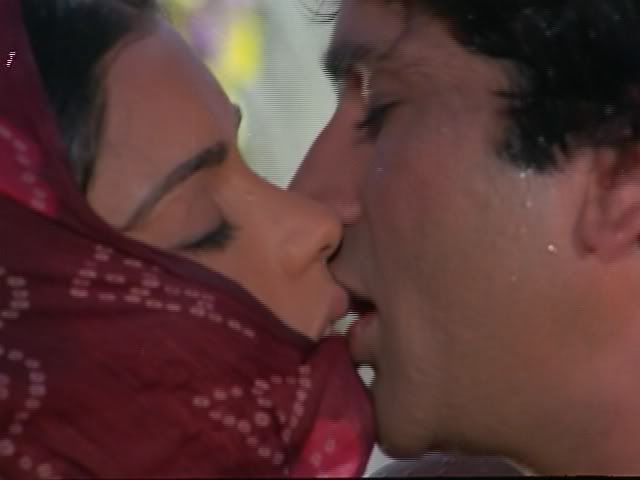
Mother of God. They're kissing.
There's a lot going on in Raj Kapoor's Satyam Shivam Sundaram (Truth, God, Beauty): Hindu spirituality, some accompanying eroticism, meditations on beauty, meditations on male-female relations. It's all related and all a bit entangled and, admittedly, we often felt bewildered by all the thematic nuances - we didn't really know what to make of it. Add to that the fact that the film is told as a modern day fairy tale complete with Willy Wonka-on-LSD-inspired aesthetics, and we felt more than a bit alienated. Everyone was just a bit too archetypal, every turn of the plot a bit too stylized, every plastic flower a bit too fuscia.
Keywords: Willy Wonka, bad acid trip, nightmarish.
Yet despite all that, we had to recognize some of Raj Kapoor's intentions as being pretty awesome (in the original meaning of the word). The dennouement is truly epic, and it's when this film stops making proclamations that it gets really good. There are moments when the cinematography is gorgeous too - though there are a lot of mistakes along the way (hello, two tone filters, what?!) - and we really have to thank Zeenat Aman for holding the whole thing together by presenting the protagonist, Rupa, as a real human being with real hopes and vulnerabilities.
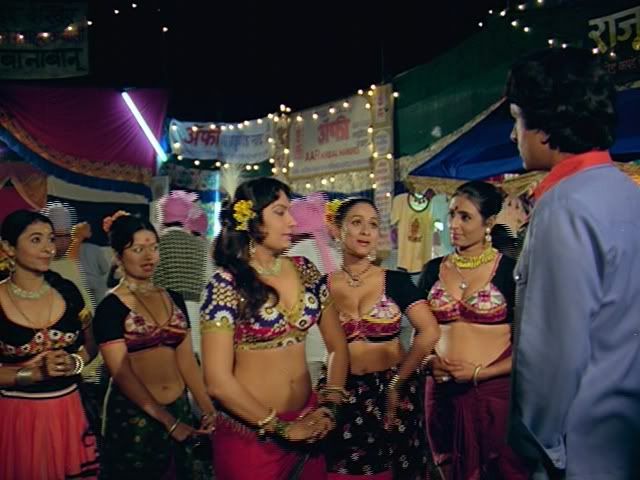
Hey, Shashi, you so fine, you so fine, you blow my mind!
The story is pretty kooky. Somewhere in an idealized, highly religious rural India, there is a village. And in this village, the local priest is celebrating Krishna's birthday just as his daughter, Rupa, is being born. His wife dies in childbirth, and apparently this is the first time it's happened in this poor village (?!), because everyone decides that Rupa must be some sort of really unlucky hell-spawn. For whatever reason, the priest backs this unenlightened opinion, and little Rupa grows up much like Cinderella or a 1950s housewife: totally screwed and unempowered. None of the kids play with her. Her father blames random incidents on her presence. The only person who's nice to her is her next door neighbor, Caca (A.K. Hangal) but even that goes awry when Rupa's face is scalded in a cooking accident at his home.
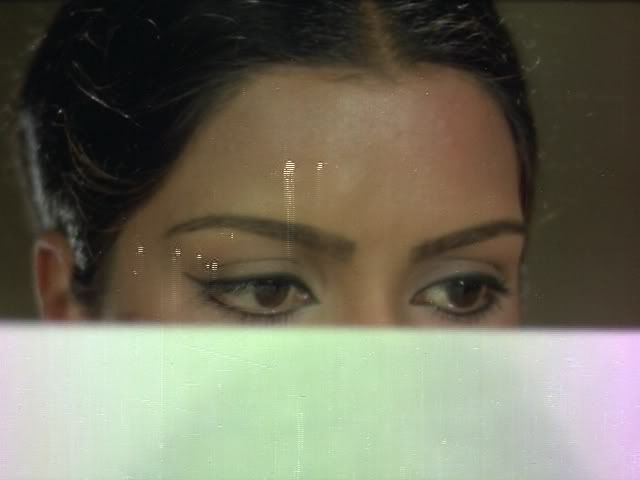
Woe. Woe.
So Rupa grows up into Zeenat Aman with a huge burn scar on her face. Everyone trash talks her, and she spends most of her days begging the temple gods to get her out of this mess and then crying herself to sleep. One day, as if he's been sent by the future, a good-looking Engineer from the City, Rajiv (Shashi Kapoor), disembarks at the train station. Rupa sees him and is immediately struck by his hotness. As is every other woman in the village, who then pursue him with zeal. Hot he may be, but Rajiv is also a little weird - he's "all alone" in the world, no family, no ties, he admits that he happily lives in a world constructed of his own fantasies, and he has a massive phobia of ugliness. To the point that he has a panic attack in front of the distorted mirrors in the local fair's funhouse. WTF?
The titular song. Usually we hate it when titles are mentioned in movies ("Ha. Dil se."), but we thought this was used to great effect. And we actually cried a bit in the end when they play it again.
Anyway, Rajiv hears Rupa singing in the temple one morning and falls immediately in love. Or lust. Or whatever. He pursues her, she hides her face and lets this painful fantasy play out for her - thinking, "Oh, it'll never work out. But it's nice to have Shashi Kapoor on my tail." One day, she gives him an ultimatum: the veil will only be lifted on her marriage night. "So let's get married!" he decides. Rupa is horrified. But her father is thrilled - finally someone's going to marry his ugly duckling, and it's even a bourgeoisie professional! But the wedding night arrives, the veil is lifted, and, yes, Rajiv has the inevitable freak-out wherein he goes totally demented. "You're not my Rupa! This is some other Rupa hell-spawn!" he cries. Even though the villagers assure him that, actually, there's only one Rupa in the village.
But Rajiv is inconsolable. He even faints. No one seems to care what this is doing to Rupa, but that's OK, because Rupa is a bad-ass who doesn't need to be empowered, thank you, she can take what she needs, you damn stupid society. And since she now has the right to Rajiv's underpants, she endeavors to live a double-life: by night, she is Veiled Rupa having an "adulterous" affair with Rajiv, by day, she is the Rejected Rupa who is actually married to Rajiv. Rajiv, in the meantime, comes out looking like a proper idiot. Oh dear. Inevitably, Rupa becomes pregnant, thus provoking the dennouement, which involves a flood a la The Ten Commandments. And the moral of the story is beauty is more than skin-deep.
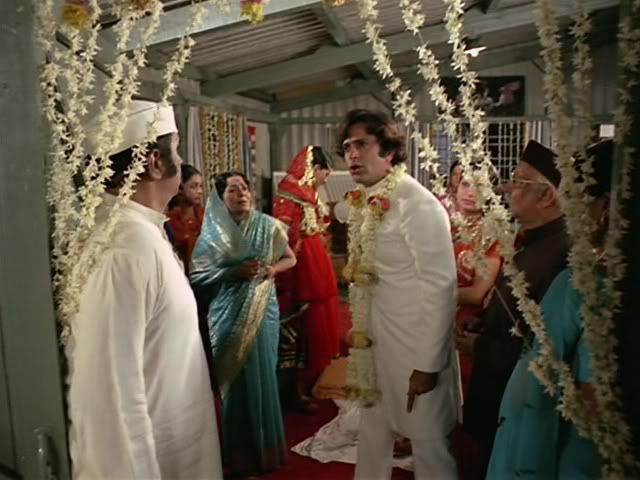
Captain Crazy.
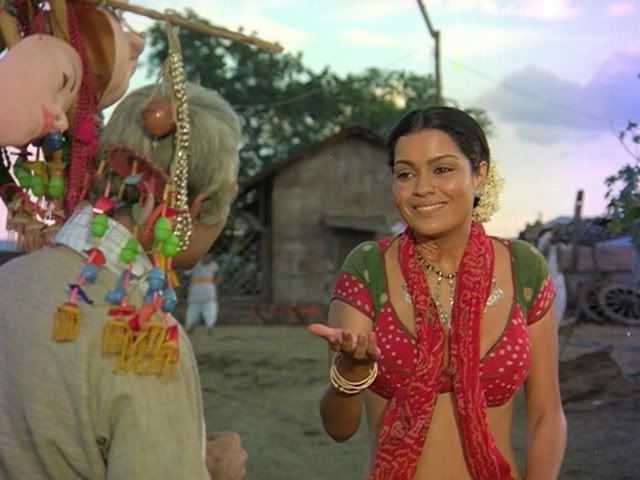
Poor, happy Rupa.
Performance-wise: Zeenat Aman is very good. While she starts off as a bit hazy and enigmatically sad, those scenes when Rajiv has started courting her and she's all Shashified and so happy really break your heart. In fact, she has this great ability to show the 15-year-old girl trying to get out; we have these windows into what she should be like (happy, frothy, energetic) but can't be, thanks to how much her situation sucks. Thanks to this three-dimensionality, the fairy tale makes more and more sense. We at the PPCC have often cried at The Ugly Duckling, and there were moments in this film when we felt tears coming on for poor Rupa's crappy life. And Shashi, he was so stupid.
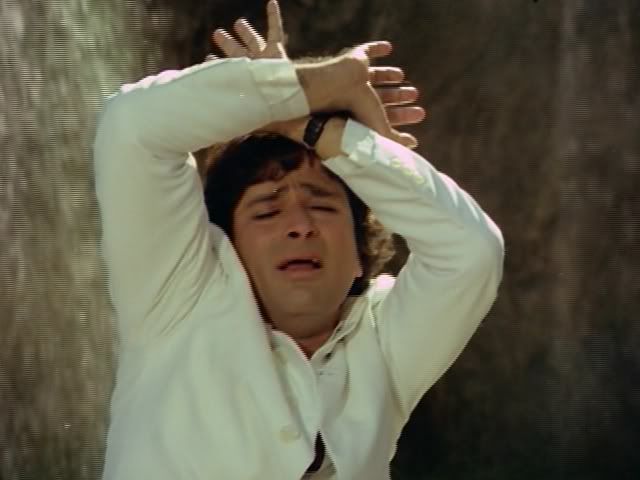
So stupid.
In fact, onto Shashi: he was fine (in both definitions of the word), though obviously it's a bit easier to just play a mental Prince Charming than the complex Rupa. He disappointed us a bit in the end, since his complete turnaround seems forced and pasted on - but that may have been the writer's fault too. All that said, however, there were some very cute moments which showed us a Shashi Kapoor we had never seen before. All the scenes where the village girls are pursuing him are really hilarious, from his aghast stares to his nervous squeaking. We at the PPCC just love Shashi Kapoor's voice and delivery, especially when he does that croaky thing ("Kya baaa-aaaat hai, bete?" in Kabhi Kabhie is a good example), and so it was likewise adorable to watch his squirming: "Huh. Huh huh. W-w-w-which girl? Heh. Err."
Now onto the thematic and filmi stuff. Like Beth, the PPCC was confused by the highly eroticized costumes Rupa wore. It's certainly commented on in the film - the other village women (also missing their sari petticoats) say she's still wearing her old clothes from childhood, and that she's half naked most of the time. But why? We at the PPCC just felt embarrassed for her, because, well, she was wearing a transparent handkerchief as a top. We think (OK, this is a theory) that, given this was directed by a man (Raj Kapoor, Shashi's older bro) and much of the Bollywood audience is men, maybe having a 3/4-nude Zeenat Aman toil under a hideous scar was meant to inspire conflicting feelings of sexy/ugly for the typical male viewer. That way they could better understand Rajiv's dilemma of being simultaneously attracted and repelled. But Beth makes the good point and we agree: why sex her up when the message is about the superficiality of such "beauty"?
That said, female viewers get their share of male erotics as well: Shashi appears wet and also 3/4-nude in a few scenes, and his own hotness is often referred to. Indeed, a troupe of village valley girls are all simultaneously smitten on first sight of him, leading to much jocularity.
And then there's the soft porny aspect of it all. We were warned about this before viewing, and we thought it referred to Zeenat's non-outfits. But, as we said, Shashi's not embarrassed to stand around wearing nothing but soaked-through boxer briefs either. This leads to most private parts being not-so-private anymore. Add to that the kissing, which shocked the hell out of the PPCC, so used to Bollywood non-kissing are we, as well as some tawdry lovemaking, and, well, yeah, it's a bit soft porny. Maybe our mind started getting a bit dirty, but we also noticed a lot of sexual imagery: Rajiv opening the waters of the dam, Rupa dancing with a sitar that's starting to look a bit phallic, Rajiv exploring that cave behind the waterfall, Rupa caressing that stone in the temple...
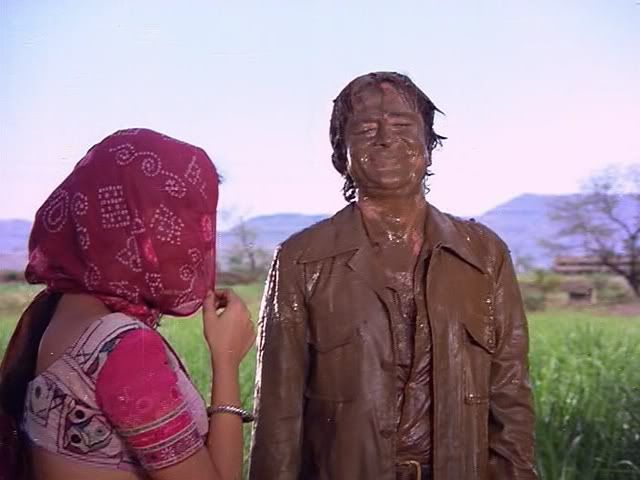
Remember that scene from Almodovar's Talk to Her?
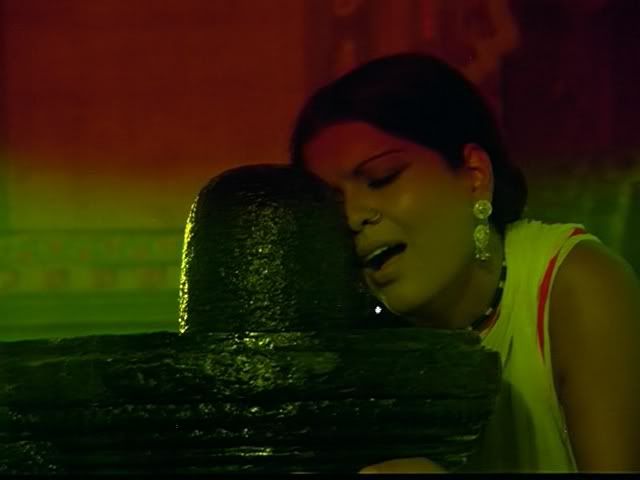
Two-tone filters and sexual imagery. Oh my.
Enough! Enough!
Anyway, the cinematography's nice too. We especially enjoyed the scenes when the dialogue audio cut out and we only saw their lips moving while music played. OK, this is really starting to sound porny now. Ummm.
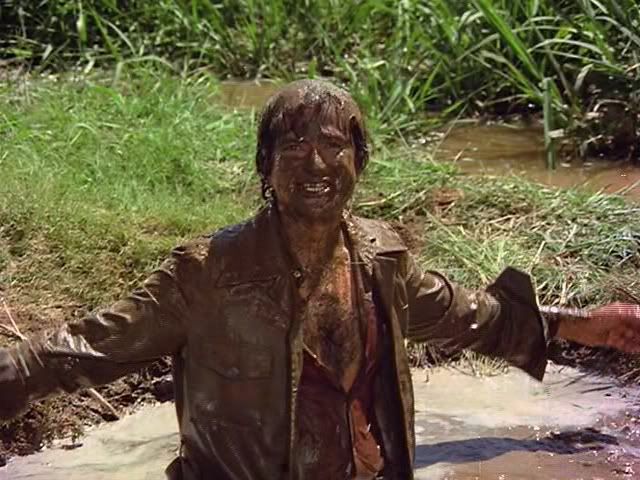
Let's see that muddy Shashi again...


6 comments:
Couldn't agree more. Rupa is so awesome - good for her for gettin' hers and playing Rajiv for the idiot that he is.
Is it just me, or is the whole idea of loving someone just for the voice, even when you've never met or seen them, especially ironic given the whole playback singer component of Bollywood? Maybe RK was making a joke about that too.
(Not to be shallow, but your descriptions of Shashi's hotness and people's reactions thereto deserve special praise.)
I'd love to show SSS to some people who have never seen any Indian movies and see how much smokes pours out of their ears.
Grrreat, laff-out-loud post! I first saw this movie when I was 8 and LOVED it! Still do, have my dvd copy! And Zeenat!! WOW!! The Indian Angelina Jolie of her time: sexy, daring, & f*ck u attitude. Gonna go watch it again for the umpteenth time!
Just left to say that the theme with ...them lovely out-of-space-magic-mushrooms (no, it´s not Kirk with one of his lovely maidens it´s Shashi with Zeenat) ... "Chanchal Sheetal Nirmal Komal" was reused in one of Shashis last movies in 1998 in "Side Street" (as music and video) where he plays Vikram Raj, an aging film star (with Shabana Azmi).
hmm, funny, don't you have usually more funny reviews? Interesting to see such a serious take. I thought SSS is just a filthy old man's phantasy. It reminded me of Bobby (which i enjoyed) and Julie (which i enjoyed much less) where also young chicks carelessly run around in sexy skimpy rags completely out-of-sync with society. Now Zeenat is even more sexy and takes that quality to the temple, seen through two tone filters, staged in papermaché settings. I guess i'm a filthy old man either, but i'd prefer that kind of Zeenat without scar and temple.
for all you grat puritans of the good world, here comes an eduacating review by sir philip lutgendorf:-
Ironically, Raj Kapoor’s extended meditation on the contingency of beauty and desire was much criticized for its “vulgarity” and “exploitation” of women’s bodies. It unfolds, in fact, like an Indian folktale costumed by Fredericks of Hollywood. Set in the imaginary Madhya Desa beloved of Bollywood, where feathered tribals gyrate erotically to celebrate the opening of a dam that will bring them prosperity and progress, it displays bevies of village belles who are low on both modesty and blouse-pieces, and a tragic heroine who cannot afford even the latter. The aptly-named Rupa (“lovely form or appearance,” played by Zeenat Aman) has a beautiful body and voice, but half her face is disfigured by scars from a childhood cooking accident, and she is scorned by the villagers as “unlucky” and unmarriageable. Enter Rajiv, a handsome, nattily-dressed engineer from the city (Shashi Kapoor), who “hates ugliness” but falls in love with Rupa by hearing her singing, and then by seeing only the half of her face that she unveils. Reasoning that the relationship can have no future, Rupa permits herself the fantasied satisfaction of being wooed by Rajiv, but is horrified when he asks her father for her hand. The ceremony transpires with Rajiv still ignorant of Rupa’s scars, until the inevitable wedding-night unveiling.
It is here that a folktale logic takes over, since Rajiv doesn’t merely reject his disfigured bride, but accuses her, over the denials of the whole wedding party, of being an evil substitute for the “beautiful” woman he wooed. Fleeing his bedroom, he rushes to the waterfall where he and Rupa used to meet. In time, Rupa herself, unable to surrender either of their fantasies, repairs there with her former half-veiling to begin a passionate “adulterous” affair with the very husband who despises and rejects her by day. Though the situation is dreamlike, the emotional power of Aman’s sorrowful heroine—forced to split herself into two in order to preserve a man’s illusions—is very real, and infects even a torrid lovemaking scene. Predictably, Rajiv’s bride, though ostensibly trapped in an “uncomsummated” marriage, is found to be pregnant—the kind of conundrum that, in a folktale, calls for a deus ex machina. Kapoor obliges by making the heavens literally open in a flood of near-Biblical proportions, underscoring the film’s underlying association of women with nature and men with civilization and artifice—a theme that, like the Shakuntala motif of the unrecognized and rejected woodland bride, resonates through a number of Kapoor films. Though the director’s climactic vision strains the limits of his special effects budget, everyone who isn’t drowned ends up, in a ruined Krishna temple, mud-spattered but clear-sighted—able to face “truth” and recognize true beauty.
for all you great puritans of the good world, here comes an eduacating review by sir philip lutgendorf:-
Ironically, Raj Kapoor’s extended meditation on the contingency of beauty and desire was much criticized for its “vulgarity” and “exploitation” of women’s bodies. It unfolds, in fact, like an Indian folktale costumed by Fredericks of Hollywood. Set in the imaginary Madhya Desa beloved of Bollywood, where feathered tribals gyrate erotically to celebrate the opening of a dam that will bring them prosperity and progress, it displays bevies of village belles who are low on both modesty and blouse-pieces, and a tragic heroine who cannot afford even the latter. The aptly-named Rupa (“lovely form or appearance,” played by Zeenat Aman) has a beautiful body and voice, but half her face is disfigured by scars from a childhood cooking accident, and she is scorned by the villagers as “unlucky” and unmarriageable. Enter Rajiv, a handsome, nattily-dressed engineer from the city (Shashi Kapoor), who “hates ugliness” but falls in love with Rupa by hearing her singing, and then by seeing only the half of her face that she unveils. Reasoning that the relationship can have no future, Rupa permits herself the fantasied satisfaction of being wooed by Rajiv, but is horrified when he asks her father for her hand. The ceremony transpires with Rajiv still ignorant of Rupa’s scars, until the inevitable wedding-night unveiling.
It is here that a folktale logic takes over, since Rajiv doesn’t merely reject his disfigured bride, but accuses her, over the denials of the whole wedding party, of being an evil substitute for the “beautiful” woman he wooed. Fleeing his bedroom, he rushes to the waterfall where he and Rupa used to meet. In time, Rupa herself, unable to surrender either of their fantasies, repairs there with her former half-veiling to begin a passionate “adulterous” affair with the very husband who despises and rejects her by day. Though the situation is dreamlike, the emotional power of Aman’s sorrowful heroine—forced to split herself into two in order to preserve a man’s illusions—is very real, and infects even a torrid lovemaking scene. Predictably, Rajiv’s bride, though ostensibly trapped in an “uncomsummated” marriage, is found to be pregnant—the kind of conundrum that, in a folktale, calls for a deus ex machina. Kapoor obliges by making the heavens literally open in a flood of near-Biblical proportions, underscoring the film’s underlying association of women with nature and men with civilization and artifice—a theme that, like the Shakuntala motif of the unrecognized and rejected woodland bride, resonates through a number of Kapoor films. Though the director’s climactic vision strains the limits of his special effects budget, everyone who isn’t drowned ends up, in a ruined Krishna temple, mud-spattered but clear-sighted—able to face “truth” and recognize true beauty.
Post a Comment